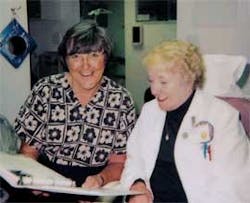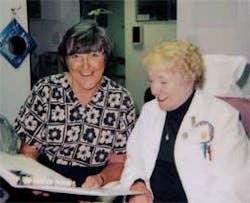Practice-Based Research
by Judy Peacock, RDH
Clinical studies provide valuable statistical information, but the resulting data do not always apply to real-life situations and may not help improve a dental practice and its patients' oral health on a daily basis. Practice-based research is a perfect and necessary complement to clinical studies. It adds personal experiences from the patients involved, and hygienists' years of professional expertise, to the hard data uncovered through clinical trials. This enables practitioners to determine and adopt the best practices in their offices.
By integrating individual clinical expertise - a pro-fessional's experience, education, observations, and skills - with external clinical evidence and studies, all dental professionals can make the best, most-informed decisions about recommendations for individual patient care. And by focusing on and identifying the best practices, professionals can achieve better patient outcomes. As such, companies are increasingly recognizing that practice-based research must go hand-in-hand with clinical research.
I was personally involved in a practice-based research study,1 and I have seen the positive results of improved patient compliance and a better, more confident overall outlook on oral health. After 40 years of practicing dental hygiene, I can safely say that practice-based research is an immediate and effective educational tool for patients, and a means to get them directly involved in their health. That, in turn, improves their overall oral care and unique oral health routine.
I enlisted two patients for a power toothbrush evaluation over a 90-day period. Both of the patients, age 60-plus, were somewhat compliant with the recommended brushing home care regimen. Both patients were in good health with no history of heart disease or diabetes. Prior to being involved in the study, both patients had been using a manual toothbrush and had never tried any type of power toothbrush. Both tended to have bleeding and inflammation around their crown margins and, consequently, were encouraged to use a rubber-tipped stimulator along with brushing and flossing. Both patients were very good about coming in for their three-month recall appointments, but I felt that this extra boost being involved in the study would increase their compliance and enthusiasm by showing them the unique benefits of a power toothbrush.
Following the study, my patients brushed longer and more frequently and they enjoyed brushing. They were more motivated, more aware of their actions and the repercussions, and actually excited to come in for a check-up. After the study, I would rate them at an A+ level of compliance. And these outcomes translated directly to improved oral health. The patients had healthier gums and reduced plaque and stains. Their periodontal status improved, thus preserving their oral health long-term and improving their overall health.
I also participated in the study. By doing so, it improved my ability to communicate the benefits of both the study and the power toothbrush to my patients. Due to the strong trust I had established with my patients, they were more apt to try a new product and to be involved in a study that I recommended and participated in myself.
Practice-based research, according to my patient participants, made them feel as if their opinions and experiences mattered, and that they had direct influence on the outcome of the study. In contrast, nearly 14 years ago I was personally involved in a clinical trial, and the study made me feel simply like a number or statistic.
Controlled clinical studies are designed to address and answer specific clinical questions in a set environment with pre-arranged criteria. By controlling every aspect of the process, it remains completely objective, ensuring that patients are randomly selected and that the results are impartial and therefore, can be generalized to the wider population.
However, this generalization creates an "average" patient. As we all know, most patients are not average due to age differences, medical compromises, and other conditions such as arthritis or a developmental disability that may have an effect on their oral health status. In real life, it's not feasible or practical to use the same regimen on all patients. Care must be individualized to achieve the best outcome.
The dental industry needs research beyond clinical studies that demonstrates and incorporates the best evidence plus knowledge of patients' preferences and clinicians' experiences to provide the best care possible. I believe the dental industry needs practice-based research.
When the Institute of Medicine study2 on patient safety and medical errors was published in 1999, it received a great deal of attention from the media, medical community, and government. The study showed that medical mistakes were the fifth leading cause of death in the United States.2 It instigated the focus on consumer- or patient-driven health care.
Hence, the name patient-driven care focuses on the patient, taking into account their own personal expectations, experiences, and values. The goal is to empower patients, giving them more say and ownership in their health care, a key concept the dental community has always advocated to further improve patient compliance and maintain oral health.
Because most dental practices are not made up of average patients, clinicians customize instructions and treatments to fit patients' needs. Getting results ultimately depends on patient compliance with those instructions. Practice-based research delivers real-life insights into whether patients use new products regularly and effectively. Practice-based research also enables professionals to have direct and constant communication with the patient to see, hear, and feel the results.
In my experience, compliance with a recommended oral health regimen - including brushing time and frequency - has been one of, if not the most pertinent problem in home oral care today. And while controlled clinical trials have not been successful in measuring compliance, practice-based research has made significant strides in this area.
Prior to the practice-based study in which I was involved, my patients were somewhat compliant. For example, they brushed only once a day and when they did brush, they rushed through it. It was evident that their oral health could improve significantly if they brushed more often and longer.
By bringing my patients into this study, I immediately saw improved compliance. They were brushing longer and more frequently. In fact, one patient brushed for four minutes versus the recommended two-minute cycle because she loved the way the power toothbrush felt (it was designed to encourage use for the recommended cycle). The patients noticed change and commented that their teeth were smoother and cleaner and that the clean feeling lasted longer. They believed they brushed longer and more effectively than with a manual toothbrush, and they enjoyed brushing more. They saw and felt the improvements themselves and were excited about it.
My patients enjoyed their office visits because they were more confident in their oral health. During this practice-based evaluation, they constantly asked questions about their oral health and hygiene status, requesting detailed updates on the improvements I noticed, which I readily shared. Participation in this practice-based research was an excellent motivator for both me and my patients.
In addition to improved motivation and compliance, I noticed visible, tangible oral care results. The participating patients showed improved periodontal status and healthier gums. They also showed a reduction in visible plaque, gingival inflammation, bleeding, and extrinsic stains. The multitude of benefits of practice-based research was clearly evident to me as the practitioner and to the patients involved.
Dental hygienists play a major role in enabling patients to achieve optimal oral health. Hygienists are friends and partners, working to establish a mutual trust, and they are educators and advocates, facilitating and influencing good oral health and hygiene.
Hygienists embody patient-driven care, working closely with dentists to provide care customized to each patient. Hygienists' education, observations, and experiences are applied uniquely to each individual patient, which is why practice-based research is so relevant and important. Practice-based research is an extremely beneficial and supportive tool as it helps empower patients to take ownership in their own care.
The dental industry, specifically suppliers and manufacturers, is rapidly recognizing the importance of the hygienist's role in the patient's oral health care, and as such, recruiting them to participate in company research. Even product marketing now reflects that change. Statistics are being published and used in savvy company promotions that quote hygienists, as opposed to or in addition to using dentists as a reputable measure (for example, four of five hygienists prefer product X). This trend will inevitably continue and increase, as the links between oral disease and systemic illness become clearer and the hygienist's role in prevention becomes even more important. As such, their experiences and observations will become more essential as well.
Participating in studies increases the recognition of the dental hygiene profession, and in turn, hygienists can significantly contribute to industry knowledge and education through their participation. Specifically, practice-based research enables professionals to educate, motivate, and impact care, and it provides a feeling of satisfaction and accomplishment by helping patients and directly seeing the results. It creates a win-win situation for both the patient involved and the hygienist. I would encourage hygienists to get involved in research and wholly support both clinical trials and practice-based research. In this way, they can further advance the industry and improve their patients' overall oral health and compliance.
Judy Peacock, RDH, has been a full-time dental hygienist for more than 40 years. She currently lives and works in San Diego, Calif. She was one of 900 hygienists who participated in the Philips Oral Healthcare Sonicare Elite Practice-Based Evaluation in January 2003.
References1 Practice-based brand identified monadic evaluation of the Sonicare Elite conducted by Morley Research and initiated in January 2003.
2 Institute of Medicine (IOM) report, "To Err is Human: Building a Safer Health System," January 1999.

